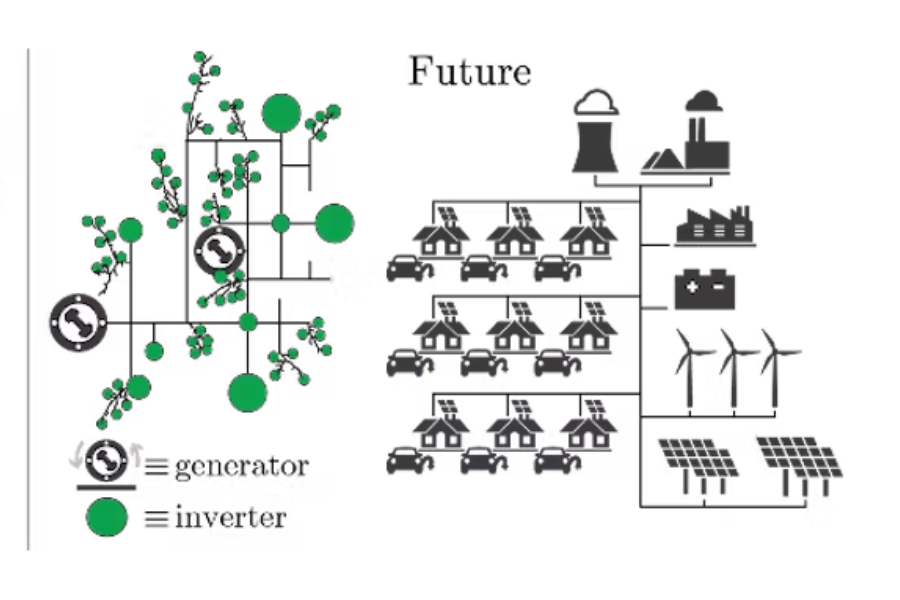There will come a time when there will be a surplus of renewable energy: what will we do with the excess?
Over the last decade, the process of decarbonisation of the energy system has intensified. Climate change and the need to reduce CO₂ emissions, on the one hand, and the development of clean, renewable and more economical technologies, on the other, have created the necessary conditions to replace traditional combustion sources with wind and photovoltaic energy.
The role of electricity grids is crucial in this process, as they provide the transport of energy to its point of consumption with minimum losses. In addition, in the future, electricity will be used much more in the transport sector, which will increase electricity demand significantly.
This scenario, together with the withdrawal of traditional generation due to decarbonisation, requires a substantial increase in production using more sustainable and cleaner energy resources.
How do electricity grids operate?
Since their inception, most of the production of electricity grids has been based on plants that convert thermal (either coal or gas or nuclear) or mechanical (hydro) energy into electricity, thus facilitating the transport of energy over long distances with few losses.
Large electrical generators connected to turbines are used for the conversion, whose inertia makes the electricity system robust and stable: it prevents blackouts in the event of serious disturbances, such as the disconnection of a generator or an area caused by human or natural causes.
With the aim of moving towards a decarbonised energy system, these types of generators are replaced by renewable sources.
At this point it is necessary to take into account that generation based on renewable sources is of lower power and more distributed characteristics. Instead of electrical machines, power electronic converters are used, which do not provide any inertial properties. In addition, the energy produced is time-variable and cannot be dispatched, thus requiring traditional back-up generators to achieve security of supply.
Towards a surplus of renewable production
All these factors have led to various technical and economic challenges in the field of integrating renewable energies into electricity grids and energy markets.
With the ambitious plans of all governments to decarbonise the energy system, more and more renewable sources will be connected to the electricity grids.
There will come a time, expected from 2030 onwards, when there will be a significant surplus of installed renewable capacity in Spain. It is expected that during the day it will even exceed demand.
There will come a time, expected from 2030 onwards, when there will be a significant surplus of installed renewable capacity in Spain. It is expected that during the day it will even exceed demand.
There will then be hours of excess renewable energy when the system will not allow all producers to generate at full capacity due to the configuration of the energy market, which defines the production mix.
What do we do with the surplus energy?
In those periods with possible excess production, what do we do with that energy? Do we waste it? Do we use it as a reserve? How can we compensate producers who have adjusted their generation or have to stop it?
One of the most obvious solutions is storage; however, it has both technical and economic limits. Although there are different energy storage technologies applied in electricity grids, in general there is very little storage capacity compared to the production capacity needed.
As Red Eléctrica explains, “electrical energy can be easily generated, transported and transformed, but it is difficult to store it in large quantities”. For this reason, electricity grids always make an instantaneous energy balance between production and demand.
Another option is to increase the use of demand management methods and the concept that demand follows production (the opposite of what we have today). Demand can be flexible, however, only within a certain range, so it cannot always provide the solution.
From the above, it is clear that the value of ancillary services in the grid will increase, especially those related to the robustness of the electricity system such as inertia and energy reserves.
If producers are enabled to offer these services, they could earn money not only in terms of energy produced, but also for services provided to the grid. This means that not all renewable plants will have to produce maximum power all the time, it will be sufficient that they are connected to the grid and available to ramp up or down the delivered power when disturbances in the system are detected.
To participate in these new markets for ancillary services, the control system of power electronics converters has to be adapted to the new requirements.
How to integrate renewables in a smart way?
Researchers at IMDEA Energía’s Power Systems Unit are working on the development of new control algorithms for power converters that serve as interfaces for renewable sources and batteries.
In particular, we are investigating a type of control called grid-forming, capable of emulating inertia (providing synthetic inertia) while supporting voltage and frequency control in power grids. These features enable renewable sources to become not only energy producers, but also grid service providers, harnessing excess capacity to strengthen electricity grids.
Our preliminary results are encouraging and demonstrate that in the future it will be possible to achieve the highest levels of reliability in power grids through improvements to the converter control system. However, certain changes in the regulatory framework are also needed, such as those related to grid connection rules and the functioning of energy markets and ancillary services markets.
Much research remains to be done to put the energy transition towards clean and renewable technologies on track. On this path, the main objective remains to ensure continuity and quality of supply for all ever-changing and increasingly demanding electricity demands.
More information: https://theconversation.com/llegara-un-momento-en-que-sobre-energia-renovable-que-haremos-con-el-exceso-201316




